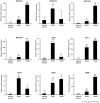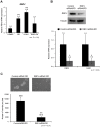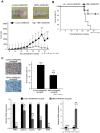RBPJ is a novel target for rhabdomyosarcoma therapy
- PMID: 22792167
- PMCID: PMC3392254
- DOI: 10.1371/journal.pone.0039268
RBPJ is a novel target for rhabdomyosarcoma therapy
Abstract
The Notch pathway regulates a broad spectrum of cell fate decisions and differentiation processes during fetal and postnatal development. In addition, the Notch pathway plays an important role in controlling tumorigenesis. However, the role of RBPJ, a transcription factor in the Notch pathway, in the development of tumors is largely unknown. In this study, we focused on the role of RBPJ in the pathogenesis of rhabdomyosarcoma (RMS). Our data showed that Notch pathway genes were upregulated and activated in human RMS cell lines and patient samples. Inhibition of the Notch pathway by a γ-secretase inhibitor (GSI) decreased the in vitro proliferation of RMS cells. Knockdown of RBPJ expression by RNAi inhibited the anchorage-independent growth of RMS cells and the growth of xenografts in vivo. Additionally, overexpression of RBPJ promoted the anchorage-independent growth of RMS cells. Further, we revealed that RBPJ regulated the cell cycle in RMS xenograft tumors and decreased proliferation. Our findings suggest that RBPJ regulates the RMS growth, and that the inhibition of RBPJ may be an effective therapeutic approach for patients with RMS.
Conflict of interest statement
Figures





Similar articles
-
Inhibition of the Notch-Hey1 axis blocks embryonal rhabdomyosarcoma tumorigenesis.Clin Cancer Res. 2011 Dec 1;17(23):7324-36. doi: 10.1158/1078-0432.CCR-11-1004. Epub 2011 Sep 23. Clin Cancer Res. 2011. PMID: 21948088 Free PMC article.
-
Loss of the Notch effector RBPJ promotes tumorigenesis.J Exp Med. 2015 Jan 12;212(1):37-52. doi: 10.1084/jem.20121192. Epub 2014 Dec 15. J Exp Med. 2015. PMID: 25512468 Free PMC article.
-
Inhibition of Notch3 signalling induces rhabdomyosarcoma cell differentiation promoting p38 phosphorylation and p21(Cip1) expression and hampers tumour cell growth in vitro and in vivo.Cell Death Differ. 2012 May;19(5):871-81. doi: 10.1038/cdd.2011.171. Epub 2011 Nov 25. Cell Death Differ. 2012. PMID: 22117196 Free PMC article.
-
Transcription Factor RBPJ as a Molecular Switch in Regulating the Notch Response.Adv Exp Med Biol. 2021;1287:9-30. doi: 10.1007/978-3-030-55031-8_2. Adv Exp Med Biol. 2021. PMID: 33034023 Review.
-
New insights into signalling-pathway alterations in rhabdomyosarcoma.Br J Cancer. 2015 Jan 20;112(2):227-31. doi: 10.1038/bjc.2014.471. Epub 2014 Sep 11. Br J Cancer. 2015. PMID: 25211658 Free PMC article. Review.
Cited by
-
Elevated RBP-Jκ and CXCL11 Expression in Colon Cancer is Associated with an Unfavorable Clinical Outcome.Cancer Manag Res. 2021 May 5;13:3651-3661. doi: 10.2147/CMAR.S298580. eCollection 2021. Cancer Manag Res. 2021. PMID: 33981164 Free PMC article.
-
A Novel Notch-YAP Circuit Drives Stemness and Tumorigenesis in Embryonal Rhabdomyosarcoma.Mol Cancer Res. 2017 Dec;15(12):1777-1791. doi: 10.1158/1541-7786.MCR-17-0004. Epub 2017 Sep 18. Mol Cancer Res. 2017. PMID: 28923841 Free PMC article.
-
Angiogenic cytokines are antibody targets during graft-versus-leukemia reactions.Clin Cancer Res. 2015 Mar 1;21(5):1010-8. doi: 10.1158/1078-0432.CCR-14-1956. Epub 2014 Dec 23. Clin Cancer Res. 2015. PMID: 25538258 Free PMC article.
-
Hyper-activation of Notch3 amplifies the proliferative potential of rhabdomyosarcoma cells.PLoS One. 2014 May 5;9(5):e96238. doi: 10.1371/journal.pone.0096238. eCollection 2014. PLoS One. 2014. PMID: 24797362 Free PMC article.
-
Abnormal expression and mutation of the RBPJ gene may be involved in CD59- clonal proliferation in paroxysmal nocturnal hemoglobinuria.Exp Ther Med. 2019 Jun;17(6):4536-4546. doi: 10.3892/etm.2019.7475. Epub 2019 Apr 10. Exp Ther Med. 2019. PMID: 31086586 Free PMC article.
References
-
- Wachtel M, Schafer BW. Targets for cancer therapy in childhood sarcomas. Cancer Treat Rev. 2010;36:318–327. - PubMed
-
- Rodeberg D, Paidas C. Childhood rhabdomyosarcoma. Semin Pediatr Surg. 2006;15:57–62. - PubMed
-
- Wachtel M, Schafer BW. Targets for cancer therapy in childhood sarcomas. Cancer Treat Rev. 2010;36:318–327. - PubMed
-
- Perez EA, Kassira N, Cheung MC, Koniaris LG, Neville HL, et al. Rhabdomyosarcoma in Children: A SEER Population Based Study. J Surg Res. 2011;170:e243–e251. - PubMed
MeSH terms
Substances
LinkOut - more resources
Full Text Sources
Research Materials

